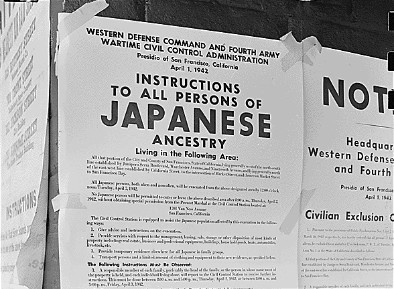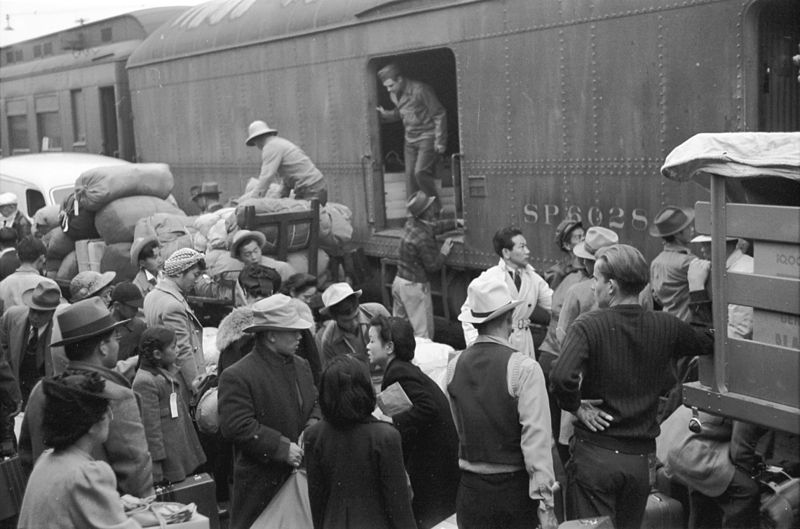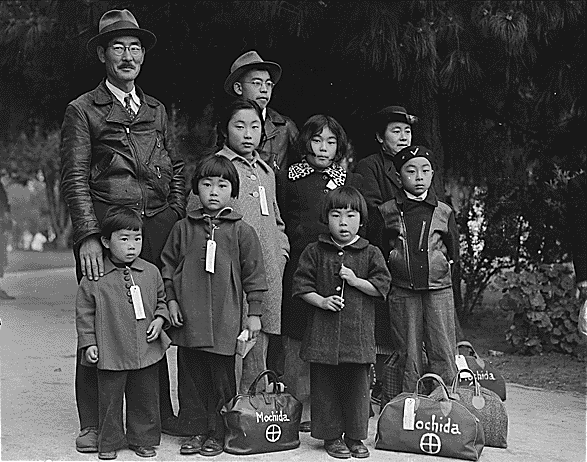Executive Order 9066 |
|||||
Early on the morning of December 7, 1941, the Imperial Japanese forces bombed Pearl Harbor, a U.S. naval base in Hawaii. Americans had been conflicted about entering World War II up until that moment. Some Americans wanted to stay out of the War completely while others urged the president to join the Allies in fighting Hitler in Europe. The shock of the bombing brought Americans together, and President Roosevelt declared war on Japan and her allies, Germany and Italy. (Partridge, 1998, p.81) The Japanese military moved quickly. They won a series of spectacular victories in
the Pacific. By February 15, 1942, the
Japanese had captured Guam, Hong Kong, Manila, and Singapore. (Partridge, 1998, p.81) Anti-Japanese hysteria increased in America with every Japanese victory. Americans were afraid Japan would attack the West Coast. They thought large numbers of Japanese and Japanese Americans living on the West Coast would help the Japanese take over the United States. (Partridge, 1998, p.81) The Japanese living in America (the Issei),
and their children, Japanese Americans (the Nisei), were intensely loyal
Americans. (Kerber, De Hart, & Dayton, 2011, p.537) The Nisei immediately tried
to prove their patriotism. Many Nisei
burnt their family photos of relatives dressed in kimonos, destroyed books
written in Japanese, and threw away their stunning ceremonial kimonos and
Samurai swords. The five thousand
Japanese Americans who were in the military at the time of the attack on Pearl
Harbor continued to serve. The Japanese
American Citizens’ League sent a telegram to President Roosevelt stating they
were prepared to fend off the invasion along with their fellow Americans. (Partridge, 1998, p.82) All of their efforts made no
difference. On February 19, 1942,
President Roosevelt issued Executive Order 9066. (Partridge, 1998, p.82) This order called for the forcible removal of
all people of Japanese descent living on the West Coast. All persons of Japanese ancestry were to go to relocation centers
for the remainder of the war. These
centers were set up in isolated, far-away places with barrack-like housing
surrounded by high barbed wire fences, tall towers, searchlights, and armed
guards. (Partridge, 1998, p.82) These people had not committed any
crimes. They had not broken any laws. They did not receive any trial, yet they were
going to be imprisoned. It was popularly
referred to as an internment. It was
legally an incarceration. These American’s
civil liberties were snatched away.
Their basic freedoms had been taken from them even though these rights
had been guaranteed to all Americans by the Bill of Rights. America was also at war with Germany and
Italy, but Americans of German and Italian ancestry were not being relocated. (Partridge, 1998, p.83) Each family of Japanese descent was
assigned a number and told to prepare for departure in just a few days. They had to store or sell their cars,
furniture, and personal belongings.
Homes had to be rented or sold.
Businesses had to be closed, farms were deserted, and family pets had to
be left behind. They departed with only the
items that would fit into suitcases.
These victims had no way of knowing where they were going, how long they
would be staying, or how they would be treated.
When departure day came they stood in long lines for hours waiting to be
checked in by the military police. (Partridge, 1998, p.83) This YouTube video gives some insight to what Executive Order 9066 meant to Japanese Americans. |
 Location: First and Front Streets, San Francisco, California. Exclusion Order posted to
direct Japanese Americans living in the first San Francisco section to evacuate. Retrieved from: http://www.archives.gov National Archives] ARC#536017 Re  Los Angeles, California. Japanese Americans going to Manzanar gather around a baggage car at the old Santa Fe Station. (April 1942) Retrieved from: http://memory.loc.gov/pnp/fsa/8a31000/8a31100/8a31149r.jpg 
|
||||